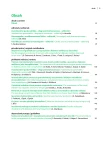Autoimmune pancreatitis – diagnostic consensus
Authors:
Petr Dítě 1; Ivo Novotný 2; Bohuslav Kianička 3; Martin Rydlo 1; Hana Nechutová 3; Arnošt Martínek 1; Magdalena Uvírová 4; Martina Bojková 1; Jana Dvořáčková 5
Authors‘ workplace:
Akademické centrum gastroenterologie Interní kliniky LF Ostravské univerzity a FN Ostrava
přednosta doc. MUDr. Arnošt Martínek, CSc.
1; Gastroenterologické oddělení MOÚ Brno, vedoucí pracoviště MUDr. Milana Šachlová, CSc. et Ph. D.
2; Gastroenteroloígické oddělení II. interní kliniky LF MU a FN u sv. Anny Brno, přednosta prof. MUDr. Miroslav Souček, CSc.
3; Vědecký a výzkumný institut Agel, pobočka Ostrava-Vítkovice, CGB laboratoř, ředitelka společnosti RNDr. Magdalena Uvírová
4; Ústav patologie LF OU a FN Ostrava, vedoucí ústavu doc. MUDr. Jaroslav Horáček, CSc.
5
Published in:
Vnitř Lék 2015; 61(2): 114-118
Category:
Review
Overview
The autoimmune type of pancreatitis represents the specific disease of pancreas, with significant contribution of autoimmune processes in its etiopathogenesis. Currently, there are two proved subtypes of this particular pancreatopathy, which are defined clinically, histomorphologically and serologically. They have many histomorphological signs in common, but differ in the presence of so-called granulocytic epithelial lesions (GEL), which are absent in subtype 1. The subtype 1 is characterized by the presence of gammaglobulines, esp. immunoglobuline G4 and IgG4 positive extrapancreatic lesions. The subtype 2 is typically associated with the inflammatory bowel diseases, esp. ulcerative colitis. But the common characteristic of both subtypes is the fact response to applied steroid treatment. Due to diverse diagnostic criteria in the past, in 2011 the consensus for the diagnosis of autoimmune pancreatitis was announced. It is based on clinical symptoms, biochemical results, the results got by using of imaging methods, histomorphology and positive response to steroid treatment. The matter to be solved is the question of early differential diagnosis between focal autoimmune pancreatitis and adenocarcinoma of pancreatic head. From imaging methods are MRI/CT, MRCP (in Asia ERCP), EUS with targeted biopsy of the gland (under EUS control), are recommended as the methods of choice.
Key words:
autoimmune pancreatitis – CT/MRI – endoscopic retrograde cholangio-pancreatography – granulocytic endothelial lesion (GEL) – immunoglobulin G4 – MRCP – steroids
Sources
1. Okazaki K, Kawa S, KamisawaT et al. Clinical diagnostic criteria of autoimmune pancreatitis: revised proposal. J Gastroenterol 2006; 41(7): 626–631.
2. Sugumar A, Kloeppel G, Chari ST et al. Autoimmune pancreatitis: pathologic subtypes and thein implications for the diagnosis. Am J Gastroenterol 2009; 104(9): 2308–2310.
3. Chari ST, Kloeppel G, Zhang Let al. Histopathologic and clinical subtypes of autoimmune pancreatitis: the Honolulu consensus document. Pancreas 2010; 39(5): 549–554.
4. Levy MJ, Reddy RP, Wiersena MJ et al. EUS-quided trucat biopsy in establishing autoimmune pankreatitis as the cause of obstructive jaundice. Gastrointest Endosc 2005; 61(3): 467–472.
5. Shimosegawa T, Chari ST, Frulloni L et al. International consensus diagnostic criteria for autoimmune pancreatitis: guidelines of the International Association of Pancreatology. Pancreas 2011; 40(3): 352–358.
6. Zamboni G, Lunges J, Capelli P et al. Histopathological features of diagnostic and clinical relevance in autoimmune pancreatitis: a study on 53 resection specimens and 9 biopsy specimens. Virchow Arch 2004; 445(6): 552–563.
7. Kloeppel G, Detlefsen S, Chari ST et al. Autoimmune pancreatitis: the clinicopathological characteristics of the subtype with granulocytic epithelial lesions. J Gastroenterol 2010; 45(8): 787–793.
8. Chari ST, Smyrk TC, Levy MJ et al. Diagnosis of autoimmune pancreatitis: the Mayo Clinic experience. Clin Gastroenterol Hepatol 2006; 4(8): 1010–1016.
9. Kwon S, Kim MH, Choi EK. The diagnostic criteria for autoimmune pancreatitis: i tis time to make consensus. Pancreas 2007; 34(3): 279–286.
10. Otsuki M, Chung JB, Okazaki Ket al. Asian diagnostic criteria for autoimmune pancreatitis: Consensus of the Japan-Korea Symposium on Autoimmune Pancreatits. J Gastroenterol 2008; 43(6): 403–408.
11. Sumimoto K, Uchida K, Mitsuyama Tet al. A proposal of a diagnostic algorithm with validation of International Consensus Diagnostic Criteria for autoimmune pancreatitis in a Japanese cohort. Pancreatology 2013; 13(3): 230–237.
12. Moon SH, Kim MH, Park DH et al. Is a 2-week steroid trial after initial negative investigation for malignancy useful in differentiating autoimmune pancreatitis from pancreatic cancer? A prospective outcome study. Gut 2008; 57(12): 1704–1712.
13. Naitoh I, Nakazawa T, Ohara Het al. Clinical significance of extrapancreatic lesions in autoimmune pancreatitis. Pancreas 2010; 39(1): e1-e5. Dostupné z DOI: <http://dx.doi.org/10.1097/MPA.0b013e3181bd64a1>.
14. Tauchefeu Y, Le Rhun M, Coron E. Endoscopic ultrasound- guided fine-needle aspiration for the diagnosis of solid pancreatic masses: the impal on patient-management strategy. Aliment Pharmacol Ther 2009; 30(10): 1070–1077.
15. Napoleon B, Alvarez-Sanchez MV, Gincoul Ret al. Contrast-enhanced harmonic endoscopic ultrasound in solid lesions of the pancreas: results of a pilot study. Endoscopy 2010; 42(7): 564–570.
16. Chari ST, Takahashi N, Levy MJ et al. A diagnostic strategy to distinguish autoimmune pancreatitis from pancreatic cancer. Clin Gastroenterol Hepatol 2009; 7(10): 1097–1103.
17. Naitoh I, Nakazawa T, Hayashi K et al. Clinical diferences between mass-forming autoimmune pancreatitis and pancreatic cancer. Scand J Gastroenterol 2012; 47(5): 607–613.
Labels
Diabetology Endocrinology Internal medicineArticle was published in
Internal Medicine

2015 Issue 2
Most read in this issue
- Spontaneous bacterial peritonitis
- The examination of the small intestine by magnetic resonance imaging
- Empagliflozin – the new representative of SGLT2 transporter inhibitors for the treatment of patients with diabetes 2 type
- The importance of transcutaneous oxygen tension monitoring in diabetic patient with complications
